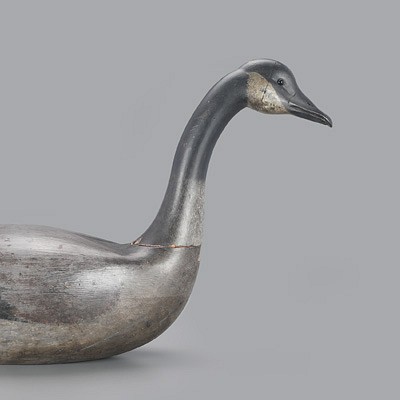Owen J. Gromme (1896-1991), Wild Turkeys
Lot 219
About Seller
Copley Fine Art Auctions
20 Winter Street
Pembroke, MA 02359
United States
Founded in 2005, Copley Fine Art Auctions is a boutique auction house specializing in antique decoys and American, sporting, and wildlife paintings. Over the course of the last two decades, the firm has set auction records for not only individual decoy makers, but also entire carving regions. Copley...Read more
Estimate:
$15,000 - $25,000
Absentee vs Live bid
Two ways to bid:
- Leave a max absentee bid and the platform will bid on your behalf up to your maximum bid during the live auction.
- Bid live during the auction and your bids will be submitted real-time to the auctioneer.
Bid Increments
| Price | Bid Increment |
|---|---|
| $0 | $50 |
| $1,000 | $100 |
| $2,500 | $250 |
| $5,000 | $500 |
| $10,000 | $1,000 |
| $25,000 | $2,500 |
| $50,000 | $5,000 |
About Auction
By Copley Fine Art Auctions
Jul 13, 2023
Set Reminder
2023-07-13 10:00:00
2023-07-13 10:00:00
America/New_York
Bidsquare
Bidsquare : The Sporting Sale 2023, Day 1
https://www.bidsquare.com/auctions/copley/the-sporting-sale-2023-day-1-12989
Lots 1-243 Copley Fine Art Auctions cinnie@copleyart.com
Lots 1-243 Copley Fine Art Auctions cinnie@copleyart.com
- Lot Description
Owen J. Gromme (1896-1991)
Wild Turkeys, 1943
signed and dated "Owen Gromme 43" lower right
oil on canvas, 30 by 24 in.
The successful reintroduction of the wild turkey to nearly the entirety of its historical range of North America is one of the great conservation stories of the last century. The onslaught of this majestic bird began with the landing of the Pilgrims at Plymouth, Massachusetts, in 1620. The number of wild turkey at the time of their arrival was, by some estimations, as many as ten million birds. Clear-cutting, a common practice in the colonies, destroyed the forests where the turkey made its home. As a result of the loss of its habitat, by 1700 local bird populations had dwindled. Benjamin Franklin was an early admirer of the wild turkey and in a letter to his daughter in 1784, he pronounced his displeasure over the choice of the bald eagle as the national bird instead of the iridescent bronze game bird.
John James Audubon (1785-1851) reported seeing wild turkeys by the hundreds along the Upper Mississippi in 1810. By 1951 the entire population in North America was estimated at a little over 300,000 birds with a legal annual harvest in fifteen states of 47,000 birds. This clearly unsustainable quota placed the bird in dire straits. Due to the tireless effort of conservation groups and hunters around the country, by 1999 the wild turkey population had rebounded to over five million birds, present in forty-nine of the fifty United States.
This work, completed in 1943, was painted at a time when turkey stocks were at near collapse. The Spanish moss in the background places the work in the South, which due to its extensive habitat, was one of the wild turkey’s last bastions for the surviving population.
Owen Gromme was born in Wisconsin in 1896, and he spent much of his childhood hunting in the wetlands and forests near his home. Gromme made his career as the Curator of Birds and Mammals at the Milwaukee Public Museum, staying in this position for over four decades. In this capacity, he traveled across the United States, as well as to Africa, documenting the wildlife he encountered. Although he was a high-school dropout, by the time of his death in 1991 Owen Gromme had received five honorary doctorates, as well as published "Birds of Wisconsin," which he also illustrated. Known for his conservation activism, his paintings reflect his love of the outdoors.
Provenance: Private Collection, Georgia
Private Collection, Wisconsin, acquired from the Sporting Sale 2011, lot 24
Literature: James E. Cardoza, "The Wild Turkey: An Astonishing Success Story," MA, 2002.Please email condition report requests to leah@copleyart.com. Any condition statement given is a courtesy to customers, Copley will not be held responsible for any errors or omissions. The absence of a condition statement does not imply that the lot is in perfect condition.Condition
- Shipping Info
-
Copley does not offer in-house packing or shipping. For clients who require shipping, please complete the Shipping Release Form and return it with your payment. The form includes a list of shippers we frequently work with.
-
- Buyer's Premium



 EUR
EUR CAD
CAD AUD
AUD GBP
GBP MXN
MXN HKD
HKD CNY
CNY MYR
MYR SEK
SEK SGD
SGD CHF
CHF THB
THB













